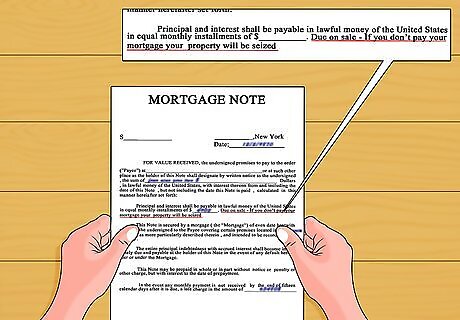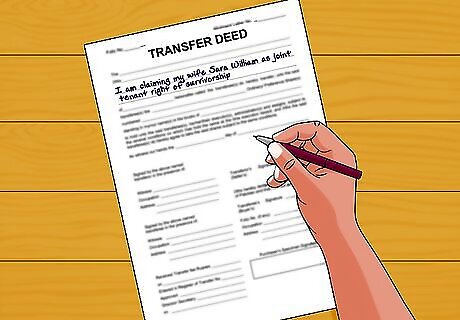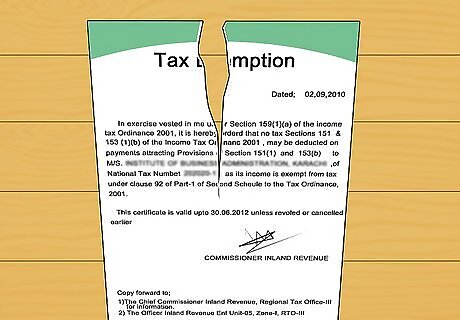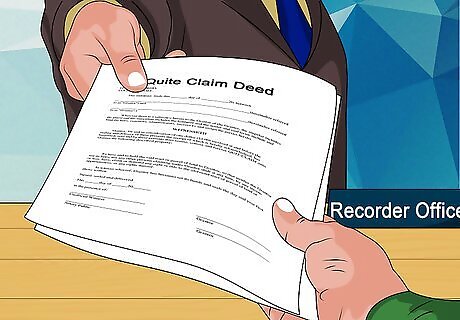
views
- Go to the county recorder’s office and get a quitclaim form.
- Fill out the form and sign it before a notary to make the transfer legal.
- Go back to your county recorder’s office to get the deed recorded so it becomes part of the official property record.
Preparing for the Transfer

Read your mortgage. If you have a mortgage on your property, it may have a “due on sale” clause. This clause gives your lender the right to demand payment in full of the balance you owe on the mortgage if you sell or transfer some portion of your ownership. The reason: The property is the bank's security that if you don't pay your mortgage, the bank can seize your property. Obviously, if you sell or transfer some of your property, that gives the bank less security. However, there are exceptions to the "due on sale" clause. These are spelled out in legislation known as the Garn St. Germain Act--specifically 12 U.S. Code § 1701j–3 - Preemption of due-on-sale prohibitions. There are nine exemptions--nine cases in which a lender may not invoke the "due on sale" clause. Exemption six is: "a transfer where the spouse or children of the borrower become an owner of the property." Nevertheless, if your mortgage has a due-on-sale clause, it doesn't hurt to notify your lender in writing of your intent to add your spouse to the deed.

Recognize you will lose some control over your property. When your name was the only name on the deed, you could do whatever you wanted to do with the property. If you add your spouse, that means he has the same interest in the property as you do, and you can’t sell it, make improvements, or do anything else to change it without his consent. Adding your spouse’s name to the deed will expose your property to any judgments against him. For example, if he has a bad debt, his creditor can sue and force the sale of your property to pay it off. Become familiar with your spouse’s financial history before you decide to add his name to your deed. If you alter the deed so that you and your spouse both own the property, instead of just you, it changes the situation in the eyes of banks, lenders, and the government. Depending on your spouse’s financial status and earnings history, adding his name to your deed may make you ineligible for refinancing, a reverse mortgage, or certain government benefits such as Medicaid.

Learn the necessary words to use to avoid probate. The typical reason to add your spouse’s name to your deed is to remove your property from the time-consuming and costly probate process, guaranteeing your spouse will get the property when you die. However, this isn’t automatically true, and there may be a more efficient way for you to accomplish the same goal. Generally speaking, adding another owner only makes the probate process more complicated. As long as you retain interest in the home, it’s still going to go through probate. If your goal is to avoid probate, you must specify in the deed that you are claiming as joint tenants with a right of survivorship. Some states have a specific deed-holding status: Tenants in the entirety. That applies only to married couples. If you live in a community property state, you can specify the home or land is community property with a right of survivorship. Arizona, California, Idaho, Louisiana, Nevada, New Mexico, Texas, Washington and Wisconsin are community property states. Otherwise, married couples usually claim property as tenants by the entirety. Your county recorder’s office will have a list of ways to claim property. Make sure you select the one that best suits your needs. To avoid probate, you must choose an ownership relationship that includes a right of survivorship. That means when you die, your spouse will absorb your ownership share of the property.
Assessing Tax Liability

Understand you may lose tax exemptions. If you have property tax exemptions, such as a homestead exemption, adding your spouse to your deed could mean you no longer qualify. This could substantially increase your property tax bill. If you’re accustomed to claiming a property tax exemption and you’re concerned you might lose it if you add your spouse to your deed, consult a tax professional.

Pay gift tax. When you add your spouse to your deed, you are giving them a gift. The IRS only allows taxpayers to gift up to $14,000 per person per year. Assuming your property is worth much more than that, adding your spouse to your deed could trigger state and federal gift tax reporting obligations. NOTE: Gifts to spouses are exempt from state and federal gift taxes if the spouse recipient is a US citizen.

Discuss capital gains with your spouse. Capital gains are taxes you pay on the profit you make from selling property. For example, if you buy a house for $100,000, that amount becomes your “basis” in the property. If you sell the house five years later for $200,000, you would have a capital gain of $100,000. If you add your spouse to your deed, he will have to use your basis if he later sells the property. That means he could pay substantially more in capital gains taxes than if he acquired the property when you died. To continue the previous example, suppose you added your spouse to the deed for the house you bought for $100,000. You die 50 years later, and your spouse decides to sell the house five years after that for $1 million. His capital gain would be $900,000. However, if you transferred the property to your spouse at your death, for example through a transfer-on-death deed, his capital gains basis would be the fair market value of the house when he acquired it. This could result in far lower capital gains taxes. Returning to the $100,000, suppose you create a TOD deed for your spouse. When you die 50 years later, your spouse acquires a house with a fair market value of $900,000. When he sells it five years later for $1 million, he only owes capital gains taxes on $100,000. Before you add your spouse to your deed, it’s important that both of you understand how it potentially affects your tax liability so you can make an informed decision and not be caught unaware later on.
Using a Quitclaim Deed

Obtain a quitclaim form from the recorder’s office in the county where the property is located. A quitclaim deed transfers whatever interest you have in a property, if any, to another person. These deeds are frequently used when adding another name to a deed, or changing a name on a deed, because they are simple, inexpensive, and don’t typically require the property owner to hire an attorney. The form will include a blank for your name, the names of the people to whom you want to transfer the property, and the legal description of the property (which you can copy from your old deed). You want to transfer the property from yourself to your spouse and yourself, making the two of you joint owners. This is also where you specify how the two of you will own the property.

Sign the deed in the presence of a notary. Without a notary seal, the deed isn’t a legal transfer. Some counties also require additional witnesses. In some areas, your spouse also must sign the deed. You can ask at the county recorder’s office when you pick up the form, although usually you can tell by whether the deed includes blanks for both of you to sign. Depending on how you claim the property, you may also need a spousal affidavit. The affidavit states that the two of you are a married couple, and must be signed by both of you under oath in the presence of a notary. For example, if you’re claiming the property as tenants by the entirety or as community property, the deed would have to be accompanied by a spousal affidavit because those methods of claiming property are only available to married couples.

Get the deed recorded. Once it’s completed and signed, your county recorder’s office, sometimes called a register of deeds, must record it so it becomes part of the official property record of the county. There will be a fee for this. You also may have to pay any property taxes that have been reassessed as a result of the change in ownership.

















Comments
0 comment